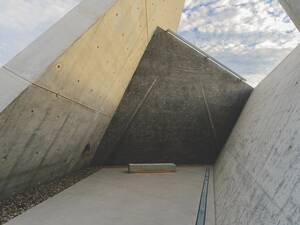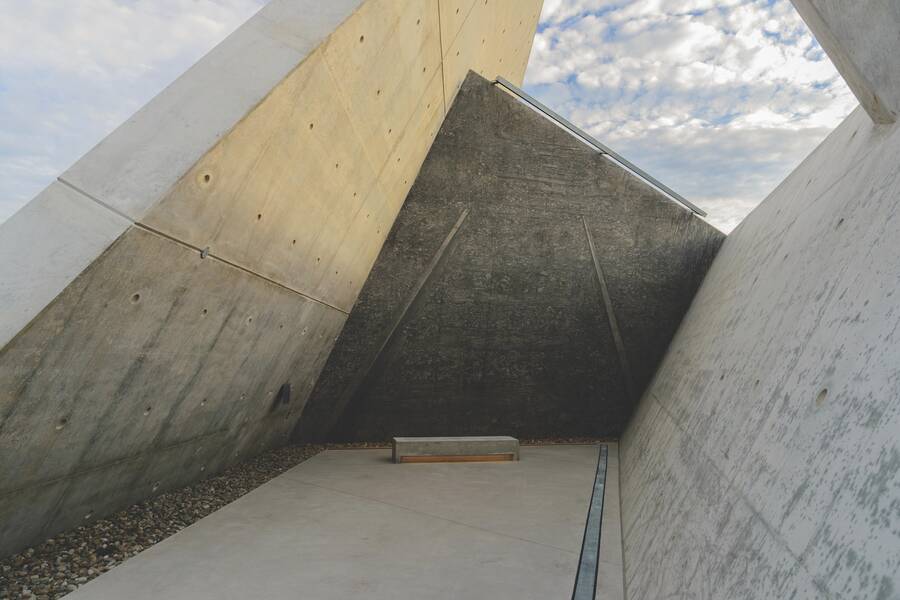
WHEN THE US HOLOCAUST MEMORIAL MUSEUM opened 25 years ago, it inaugurated a new understanding of what museums were supposed to do; since then it seems we are increasingly looking to museums to help process traumas and sort out complex social problems. David Adjaye’s celebrated National Museum of African American History and Culture, and the Memorial for Peace and Justice (the National Lynching Memorial) are only the most recent structures to do this. While secular, these ambitious projects are meant to serve as sacred repositories, as sites of pilgrimage and spiritual healing.
With the spectacular growth in museum construction over the past two decades, there’s been a parallel spike in the creation of architectural sites that memorialize the Holocaust. These projects are grand gestures to public memory, typically expensive and large in scale. They include the Bologna Shoah Memorial (completed in 2016), the Canadian National Holocaust Monument (inaugurated last year), and an Adjaye-designed London memorial, in the works. Many of these make use of deconstructivist architecture, with spatial instability as their calling card. Buildings appear to be in the process of blowing up or sliding into the ground; materials that typically convey solidity, like steel and stone, are made to float, buckle, and crack. These structures aggressively engage with bodily space—passing people through giant silos striated by beams of light or funneling them through narrow chutes—disorienting visitors with the aim of bringing out new emotions and memories. The development of these projects unfold as heavily-mediated spectacles, relying on high-profile competitions and ritualized groundbreakings to signal the creation of “important” architectural forms. It’s a matter of political and civic concern—at stake is how we mediate the past in the built environment, and the aesthetic vision we attach to memories of suffering.
Deconstructivist elements and an ostentatiousness of style, combined with government-funded, big-budget drives “to remember” are hallmarks of the new Shoahtecture. But as these projects become more ubiquitous, we have to ask ourselves: what are these architectural behemoths really for? Is it wise to entirely hand over the task of memorialization to some of the same forces—capital, industry, and the state—that helped give the Holocaust shape? And, as Nazis march again in the streets of the US and Europe, has centralizing memory in these grand repositories made it too easy to seal off, compartmentalize, ignore?
NO ONE IS MORE closely linked to Shoahtecture than Daniel Libeskind, the Polish-born architect whose deconstructivist style has become the go-to for recalling Jewish persecution and murder under the Third Reich. His latest is the monument to the victims of the Holocaust a mile from Canada’s parliament in Ottawa. It’s just one of a half-dozen Shoah-related buildings the 72-year-old has completed, with more in the works—including a memorial in Amsterdam, set to break ground at the end of the year, that will list the 102,000 names of the extinguished Dutch Jewry. The structure of the Ottawa monument consists of six triangular spaces that, from above, form a stretched Star of David. Visitors enter through a narrow slot. Inside, tilted triangular walls frame small spaces, and stairs divide the monument into two planes: you can head down into a pit of remembrance, or up onto the warped star’s ramparts, into a brighter future. This is typical of Libeskind’s playbook, where buildings aren’t containers for programming or exhibitions, as much as they are routes that lead visitors from one pilgrimage site to another, using disruptions in the ground plane and walls to tell the story of an (often traumatic) event. This corporeal reorientation is intended as a means of building empathy, of temporarily exiting the lived body in order to “see” the position of the Other—an admirable, if empirically unassessable, goal.
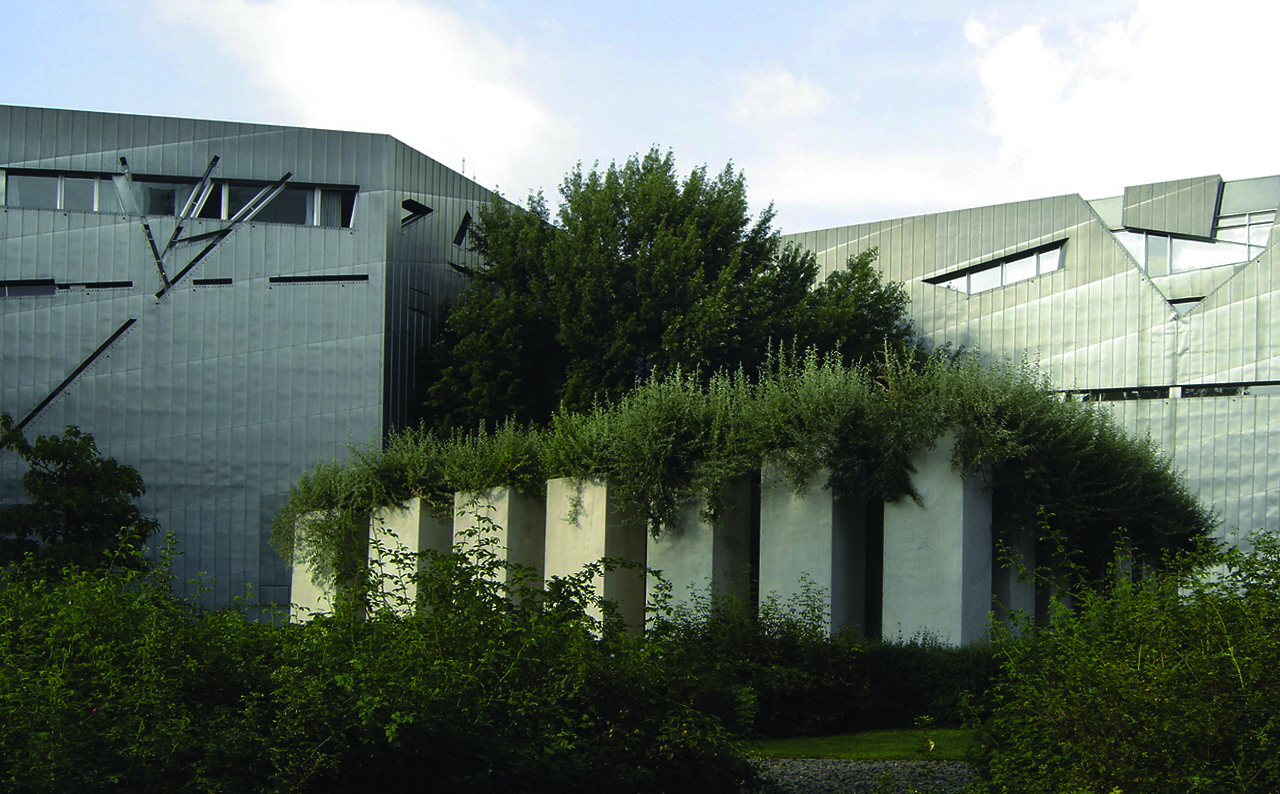
Libeskind’s career took off nearly 30 years ago, when he won the competition to create a Jewish museum in Berlin. He was in his early 40s at the time. Well-known as an educator and theorist, his designs had long been some of the most celebrated in the emergent deconstructivist movement, but they were never actually considered for construction. It was only when deployed in the service of Holocaust commemoration that Libeskind’s tumultuous forms could finally be realized. Wrecked and upended buildings started to make sense in the context of the Shoah: lacerations in the façade of the Jewish Museum symbolized the violence of antisemitism, irregular planes pointed to narratives of uncertainty. The building was convulsing from the Holocaust memories it housed. Deconstructivism’s dissonant, ahistorical orientation broke ties with modernist styles tarnished by fascism and communism, an immensely appealing proposition during the transitional period of 1990s Berlin; Libeskind’s clashing, volatile forms ensured that his work made an impression, while pulling decidedly away from preceding civic structures.
If his style served as an aesthetic break from the past, his personal narrative provided continuity and credibility. Born in Poland to Holocaust survivors, he emigrated to the US as a young teen after a brief period on an Israeli kibbutz. His timeline closes the gap between the lived experience of the Holocaust and the commemoration of the event in architecture.
The Jewish Museum Berlin was one of the first projects of a reunified Germany. After its opening in 2001, it was largely heralded as a success, a new symbol for the rehabilitated capital. The museum’s site in Kreuzberg went from a forgotten corner wedged against the Wall to a central locale in the unified city. It was a triumph for Libeskind, who quickly moved on to design other high-profile buildings. The upper floors of the museum hold objects relating to German-Jewish history, while the lower level takes visitors down three tilted hallways that symbolize continuity, destruction, and exile. Like the Ottawa monument, the Jewish Museum is formed from a distressed Star of David, unraveled until it resembles a crack or a bolt of lightning. The use, and perceived success, of deconstruction in Berlin helped to establish it as the aesthetic sensibility for all things Shoah-related; even the old-school modernist Moshe Safdie made use of many deconstructivist tropes in his early 2000s rebuild of Yad Vashem.
The rebel spirit attached to deconstructivism at its birth has now largely dissipated. Libeskind is the first to note that architectural styles are not eternal, and that anything that is not dated is probably not architecture, “it is simply construction.” Twenty years down the line and it’s hard to separate some of the innovative ingredients he used to create the Jewish Museum from the roux favored by typical “starchitecture” statement buildings (Frank Gehry’s museum at Bilbao and Zaha Hadid’s Vitra Fire Station both use colliding forms for spaces unencumbered by Shoah trauma).
But while there is nothing inherently wrong with the style of Libeskind’s Holocaust museums and memorials, however dated or retroactively clichéd, their proliferation is troubling—not because people shouldn’t memorialize the Holocaust, but because there shouldn’t be an out-of-the-box architecture to describe and contain it. There is a cheap symbolism to the deployment of Stars of David (Berlin, Ottawa) and Hebrew characters (Copenhagen, Amsterdam) as leitmotif. To see these shapes, and get their textual illusions, one must be in a helicopter (or perhaps a descending spacecraft). This speaks to Shoahtecture’s characteristic preoccupation with instant icon-status, and, more broadly, a move towards buildings increasingly designed with photography in mind—particularly from a drone’s-eye view—in service of intense publicity pushes.
When you examine the huge donations needed to underwrite big museums and monuments you start to see the problem: The old and wealthy who compose the Development Councils are keen on having the next “it” building for Architectural Digest—whether that structure adequately communicates the story of the Holocaust (or is fiscally sound) becomes secondary. The museum-building boom of the early 2000s only exacerbated this, as small institutions clamored for new wings they couldn’t necessarily afford and sought to become “destinations” in a fiercely competitive cultural sphere.
Despite these competing motivations and unholy circumstances, when ground is broken on a new museum or memorial there is a tacit, or sometimes very explicit, assumption that once rendered in impermeable materials, Shoah narratives will have a deterrent effect, ensuring that “never again” really means never. Both the US and Germany have opted for big museums and memorials in the heart of their capitals. But while “genocide prevention” is a stated goal of all of these projects, it’s not clear if they’re actually doing their job. In the months after Bill Clinton cut the ribbon on DC’s Holocaust Memorial Museum in 1993, the US mostly sat and watched as thousands of Bosnians were sniped in Sarajevo and as Rwandan Hutus killed Tutsis en masse. While it may be unreasonable to expect that museums can transform the makeup of the human spirit, one wonders if these grandiose national projects—with their solemn, but toothless ribbon-cutting ceremonies—let states off too easy.
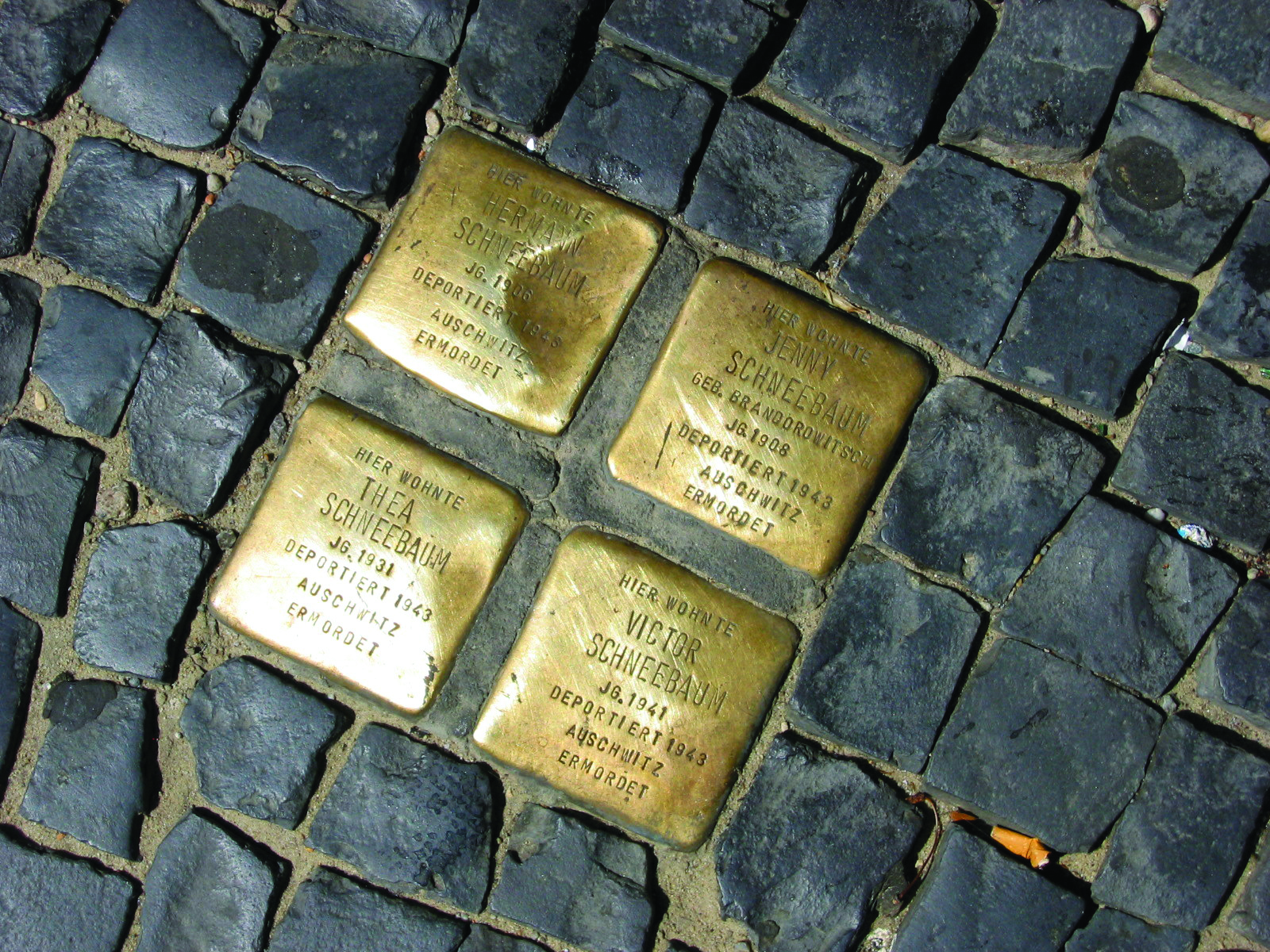
IN EXAMINATIONS OF both museums and modern memorials, we have seemingly taken for granted that big architectural projects are the most appropriate form of storytelling. They may not be.
Starting in the 1990s, some artists began to advocate for low-fi, high-impact memorials. Members of a loose group of “counter-monument” creators made works of remembrance that integrated uncomfortable memories into public spaces. Stolpersteine, or stumbling stones, are the most famous of these projects. The brass plaques are inserted into the cobblestones in front of the homes where murdered and exiled Jews once lived, disturbing the visual pattern of the street and reminding Europeans of their former neighbors (the project has spread from Germany to at least 21 other countries). It is not a government project but the initiative of one artist, Gunter Demnig, who now makes it his life’s work to install them (as many as several a day), moving from site to site in a meditative practice. Stolpersteine bear little evidence of being designed and the information they convey is simple, but their public nature and the way they spatially link past to present is striking.
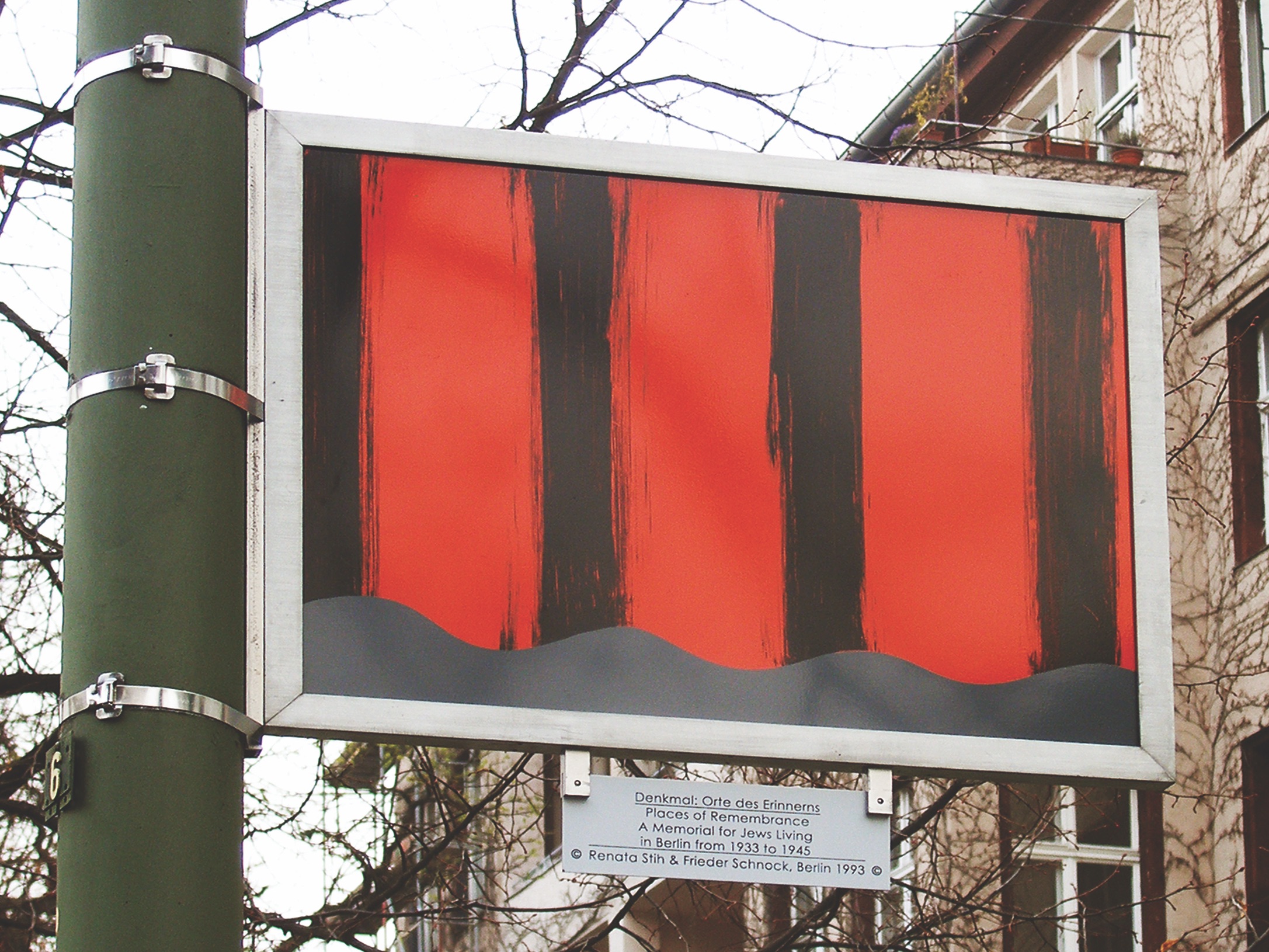
Places of Remembrance is a modest commemorative installation by the artists Renata Stih and Frieder Schnock. In Berlin’s Schöneberg neighborhood, once home to a mix of Jewish and non-Jewish Germans, a series of street signs show the steady erosion of citizenship rights that culminated in genocide. The signs present the dehumanizing Nazi laws as they may have appeared at the time, in the newspaper or posted in town squares, placing the viewer, momentarily, in the past. On the south side of Bayerischer Platz, a sign from 1933 notes that patients will no longer be reimbursed for visits to Jewish doctors. Four blocks away, an edict from July 25th, 1938, flatly states, “Jewish doctors may no longer practice.” The verso side shows a peppy illustration of a thermometer, rendered in the same high-contrast graphics as nearby signs urging pedestrians to keep a playground free of trash or drivers to slow down for kids. The work is unsettling precisely because you could miss it or, alternately, discover it inadvertently. In its seamless infiltration of the lived environment, one can feel the quotidian nature of fascism’s roll-out.
Another counter-memorial in Berlin was created by the Israeli-born artist Micha Ullman to commemorate the infamous Nazi book burning of 1933. Set in the cobblestones just off Unter den Linden is a glass pane where one can peer below street level, down into an empty library. At night it is illuminated, a trap door into Germany’s unsettling past. Unlike most of the high-flying capital-A architecture of Shoahtecture, the muted monumentality of this work has a transporting effect on the bodies of passersby, activating feelings that can’t be accessed through traditional means.
The use of these small, diffuse memorials makes sense in Berlin and other European sites of deportation and murder, and provide a needed counterweight to their official memorial projects. But how does remembrance work in the post-Shoah diaspora, in places like the US, Israel, and Australia, where survivors largely settled? A current approach of many New World Holocaust memorials is to incorporate topsoil from the European killing grounds into their design—a phenomenon that is echoed in the relics trade of 9/11 twisted steel, exported for memorials around the world, and in New York’s Irish Hunger Memorial, which relocated a stone cabin and turf from famine-stricken County Mayo to Battery Park City. The Oregon Holocaust Memorial, near Portland’s famous Rose Garden, is built around a vault that interns ash and soil from six concentration camps. Nearby, a survivor’s inscription is carved into a memorial wall: “Never will I forget the smell of Auschwitz.” Scattered on the ground leading up to the memorial are bronze casts of objects that have flown out of a broken valise: a doll, a teddy bear, a broken menorah. This manner of memorialization is content to simply bring the camp, and its imagery, closer to home, but is stunted by an unproductive preoccupation with authenticity.
What if we followed the examples of Europe’s counter-monuments: drawing more concrete links to the Shoah and scattering markers across the built environment? We could, for example, install a site-based memorial floating off the Florida coast, where the doomed MS St. Louis tried to discharge its passengers rather than send them back to their fates in Nazi Europe. We could also create a sculptural installation dedicated to the survivors who struggled to build new lives in the bungalows and public housing developments of Flushing. We could place markers at sites where nativists and domestic Nazis rallied, like Flagstaff Mountain in Boulder—known today only as a scenic lookout and weed-smoking spot, rather than the setting for Colorado’s massive Klan rallies. These distributed memories might jar us into confrontation with the past at any moment, collapsing the distance between now and then, us and Other.
EXPENSIVE MUSEUMS demonstrate that societies have dutifully acknowledged the Holocaust, and, in doing so, can move on. They are piously set up in places of national significance, opened with much ceremony, and quickly forgotten. Sure, students are brought in by the busload, and adults may wander in for crowd-pleasing programming, but they do not become part of our daily lived experience. In America today, one of the only places that holds death and suffering close are the low-income communities ravaged by gun violence, where one finds murals and shrines to fallen youth.
It’s easier to build monuments at a large scale. Fundraising for big, bold projects helps countries, cities, businesses, and philanthropists to feel that we have done something. But breaking ground on a new museum (or going there for a visit) can’t be a substitute for the painful memory work that needs to be done. Shoahtecture is showy, but, paradoxically, easily overlooked, meaning that big memorialization projects might be the first step towards forgetting. To truly disorient a viewer into greater empathy and contemplation, it may require a move away from the pharaonic scale of museums and mega-monuments and towards smaller, more direct intrusions on our space and our daily lives.
Samuel Holleran is an interdisciplinary artist and researcher, examining
public space, visual culture, and memorialization. He has worked as an
art director, researcher, and educator in the field of civically engaged
design with the Center for Urban Pedagogy in New York City, ETH-Zürich,
and Ellery Studio in Berlin. Currently, he is a researcher at the
University of Melbourne, where he is examining public participation in
the re-imagination of urban cemeteries.


